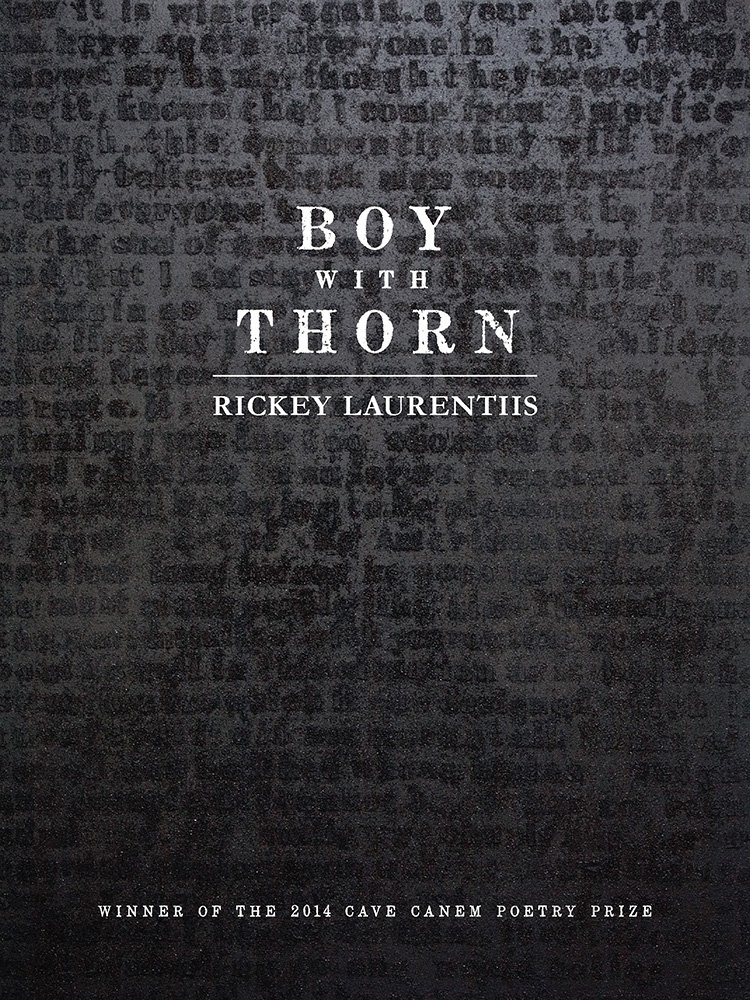Review: BOY WITH THORN by Rickey Laurentiis

Review by DIAMOND FORDE
When questioned about writer’s block in an interview for a 2016 Poets & Writers publication, Rickey Laurentiis responded, “My obsessions keep me going.” Laurentiis’ debut collection, Boy with Thorn, chosen as the 2014 winner of the Cave Canem prize, is compelled by obsession. Every thought, like meat, cannot escape Laurentiis’ poetic teeth. Meditations on the act of thinking, queer identity, and violence against the black body are ripped open, exposed to the sinews. Boy with Thorn has three divisions, creating thematic arcs of recorded history, poetic history, and personal history. Laurentiis’ book is a necessary aggression, a simultaneous acceptance and rejection of the many poets, pasts, and visual arts with which he wrestles—what Terrance Hayes calls the book’s “restlessness” and “integrity.” Nothing is convention for Laurentiis, where his poems seek “to break that boring need to always have a shadow trail its maker.”
The first arc moves primarily with and against history. Laurentiis opens with “Conditions for a Southern Gothic” and ends with a “Southern Gothic” itself. In the eighteen poems comprising this division, he is driven both by spirituality and the spectacular treatment of black bodies, in which “spectacular” connotes less of beauty than the root of the word, “spectacle.” For instance, the poem “I Saw I Dreamt Two Men,” depicts two African men lynched for their homosexuality. This poem turns critically against the mob, yes, but then moves more surprisingly against the poet himself: “Their black skin made blacker by my feeding.” In Laurentiis’ poems, no figure escapes criticism. Laurentiis’ habit of self-implication levels the field between poet, reader, and subject, and allows for a vulnerability and honesty important to the book. “I Saw I Dreamt Two Men” also marks the beginning of an identity translation of sorts, in which an “I” pervades the collection, sliding into the identities and paintings that spark Boy with Thorn. For example, in “Black Iris,” inspired by an oil painting by Georgia O’Keeffe, Laurentiis writes:
“I should want to fit into it, stand up in it,
rest, as would any beast inside a stable.
I should want to own it, force it mine,
to know it is my nature, and of
course don’t I? Why shouldn’t I want?”
While the syntactical structure of this stanza at first reads as decisive, deliberate, and defiant, the phrase “as would any beast inside a stable” creates unexpected intimacy; the speaker reveals an association with themself as unhuman, forcing me to approach the final questions of the stanza with a concrete sense of the vulnerability pervading the collection as a whole.
Perhaps the poem that most memorably invokes a voice of self-question is “Vanitas with Negro Boy.” Like “Black Iris” before it, “Vanitas” is inspired by an oil painting, this time by artist David Bailly. In this poem, an italicized voice appears, wondering, “And what is my boyhood, and where is it from?” Statements such as this connect to other thematic elements of the collection. For example, Laurentiis introduces some compelling conclusions about the act of thinking. He visualizes it as “the thinking imagination / sprawled like a breathing vine.” While discussing this poem in an interview on Brooklyn Poets, Laurentiis mentions that “Thinking is a kind of work.” He would continue turning to new deductions about thought and imagination, even in the second arc of the collection. This arc unpacks poetic history. It is occupied by a single lyric poem, “Of the Leaves That Have Fallen,” which directly confronts Wallace Stevens’ “Like Decorations in a Nigger Cemetery.” Many of the themes from previous poems appear here.
The last section of Laurentiis’ book works primarily in personal history. It is important to point out that this history does not necessarily operate in personal narrative. Rather than fixating on a conveyance of the story of self, Laurentiis’ final section operates on impressionist unravelings of “I.” An “I” that is southern, an “I” that is black and male, an “I behaving finally by instinct alone.” Perhaps the poem most emblematic of this section is “Black Gentlemen”, where a speaker’s conceived self conflicts with the world’s conception of him.
Laurentiis reveals that being human is an act of critical reflection. Identity does not escape the influence of the social. However, identity can and does lend itself to multiplicity. Laurentiis’ collection encourages an investigation of these multiple identities. However, this encouragement does not come with the goal of discovery in mind. Rather, it is the act itself that is important; investigation is a way to outlive and outstretch the limits of the self. As Laurentiis wonders, “what nothing can exist / if thought does”?